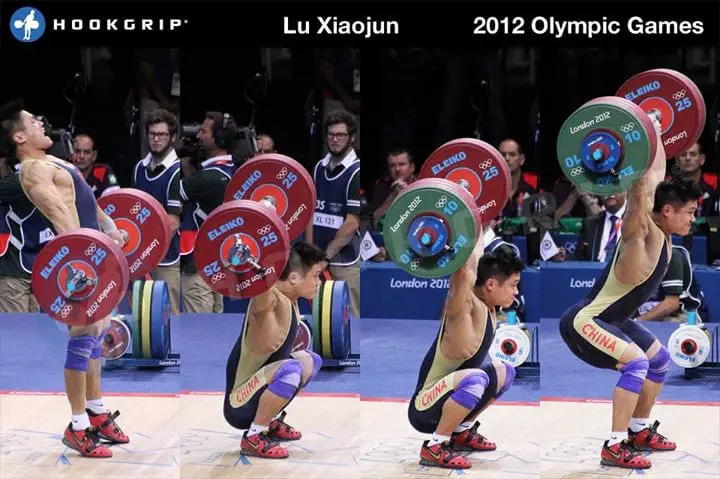
The Squat Jerk is an extremely complex movement and should be used only by very advanced/elite lifters.
This lift differs from the Power Jerk (where you perform approximately a quarter squat). You will be in a deep squat for this lift (well past parallel).
You should have a strong knowledge and technique of the easy/intermediate Olympic lifts before even thinking about attempting this lift.
The Squat Jerk will also require you to have very good shoulder mobility, overhead stability and leg strength.
This lift requires you to have total body strength. You will be in a deep squat with your arms above your head while you balance the weight.
This lift will also make you perform two squats with the weight for you to complete one repetition.
You are required to front squat the weight overhead to get it above you and then will perform the deep squat portion.
The Jerk also has rather close hand positioning compared to the snatch adding to the difficulty of this lift.
Most lifters find stabilization is extremely difficult for this movement.
Exercise Difficulty Level
The squat jerk is an expert/advanced level exercise. Only people who are at an advanced level of physical fitness and exercise experience should attempt this lift.
You should have a good handle on all basic compound exercises. Especially focus on perfecting your squatting (front and back versions), and overhead pressing to strengthen your shoulders.
You should then spend time practicing a variation of the different beginner and intermediate Olympic lifts before adding this into your routine
This exercise is for people who have been practicing with less compromising (easier movement), Olympic lifts for a few years.
Many lifters find that practicing the Clean-Grip Snatch helps to improve their shoulder mobility for this lift. Some prefer to perform the variation where their feet do not leave the floor.
Woman may find the Squat Jerk more difficult since there arms and shoulders are not as strong relative to their legs and back as men's are.
How To Do The Squat Jerk Image Demenstration

How To Do The Squat Jerk Technique
- Move into the Jerk rack position (weight racked on the front of your shoulders).
- Your feet should be placed Hip width apart with your toes pointing slightly out.
- Keep your feet flat on the floor having the weight balanced on your heels.
- Bend flexing at your knees, do not allow your hips to move backward. Your core should remain vertical while balancing the weight on your heels.
- Go slightly down and then drive through your heels with your legs as powerfully as you can helping to drive the barbell up.
- When you have finished extending your legs, begin pushing against the bar at the same time move your head out of the path of the bar.
- At this time you need to quickly lift your feet once they leave the ground immediately put them into the receiving position (squat stance).
- Push your arms to a locked out overhead position as you are moving into the bottom of a deep squat (ass to grass squat).
- The bar is to stay over the front of your heels, keep your head and chest up as you drive from your heels and move back into the standing position.
- Once in the standing position lower the bar back onto your shoulders.
How To Do The Squat Jerk Video Demenstration
Benefits From Performing The Squat Jerk
The main benefit would be for people who are training for using this lift in competition.
With lighter weights, it helps with training your overhead strength and stability.
Some lifters who find difficulty with the split jerk may find more comfortable with the Squat Jerk.
Squat Jerk Muscles Used
Primary Muscles
- Quadriceps
Secondary Muscles
- Shoulders
- Forearms
- Biceps
- Triceps
- Traps
- Lower Back
- Lats
- Hamstrings
- Abdominals
- Glutes
- Calves
You may also like
The Clean Pull Exercise
All About The Kettlebell Renegade Row Exercise
The Bulgarian Deadlift Exercise
The High Hang Clean Exercise
Looking to gain more strength or lose some weight? We offer free fitness tools to help you reach your fitness goals. Register for free while we are in beta and get free lifetime access to our fitness tools that include an easy to use Calorie Counter, High-Intensity Interval Timer, Multiple Fitness Calculators and our Exercise Logger.